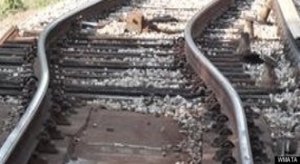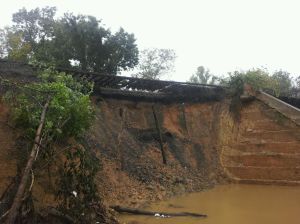Recent Blog Posts

Now that the warm weather is here, you have probably noticed that it is accompanied by speed restrictions most often related to heat and flooding. These restrictions are necessary for safety, but inevitably, cause delays. There are many reasons for delays and below, we try to highlight some of the major ones:
Heat related speed restrictions:
What exactly is a heat restriction? In short, heat restrictions are orders given to railroad engineers to reduce their speed over a given section of track between the hours of 1:00 pm and 7:00 pm when the ambient temperature is predicted to be 90 degrees. Passenger trains must operate 20 mph slower than their maximum operating speed.
For all practical purposes, that usually means VRE's trains can run at 50 mph during a heat order. But why impose these heat restrictions?
Trains ride upon two ribbons of steel. This steel has been metallurgically engineered to be incredibly strong and stable, yet incredibly flexible. This flexibility, which serves well in the creation of curved track and during periods of exceptional cold (when rail remains strong) can be a double edged sword. When many miles of rail are subjected to intense heat, the rail becomes incredibly hot. The stone track-bed and the consistent lack of shade do nothing to help this problem either. Since the rail is firmly anchored into the wooden railroad ties, it has little room to move, which helps to keep trains moving at great speeds stable. As we all learned in elementary school, heat causes expansion and the superheated rail can increase in length measuring in several inches over a great distance. Since there cannot be any gaps in a rail to allow for this expansion, pressure builds up in the rail as it tries to expand lengthwise but can't. With no room to expand, the rail can bow outward like a plastic ruler squeezed at each end between your fingers. It pulls the wooden ties right out of the stone track-bed with it and creates a sharp curve. When this occurs, the track has what is known as a “sun kink” or “heat kink”.
 These occur without warning and if unchecked, can create a very unstable operating situation for a train.
These occur without warning and if unchecked, can create a very unstable operating situation for a train.
When railroad maintenance officials see that conditions may be right for such a situation, they issue heat warnings and our trains end up travelling slower, because higher speeds add to the friction which adds to the heat. When trains slow down, there is less friction and therefore less heat which reduces the bending of the rail.
In the grand scheme of things, heat restrictions do not really count for that great of delay (8 to 10 minutes at the most which can often be made up). However, when it is hot enough for heat restrictions to be needed, it is also hot enough for the temperatures to affect mechanical equipment and signals and switches along the tracks. The combination of these two factors, mechanical breakdowns and slow speeds can, unfortunately, result in delays.
While no one likes to be delayed, even if it is only 8 to 10 minutes, the use of speed restrictions is definitely a case of being “better safe than sorry”.
Flood related speed restrictions:
The most common delay during stormy weather is caused by wind and heavy rain, with both CSX and Norfolk Southern having policies in place that deal with severe weather. If the National Weather Service puts out a flash flood warning, for example, CSX's policy states that trains can go no faster than 40 mph; NS's policy states that no train can go faster than 20 mph.
Both policies follow the same theory most of us do when driving in heavy rain: slowing down enables the engineers to more safely navigate through areas with limited visibility. Most importantly, should deep water cover the tracks, or if a section of track is washed out, a slower rate of speed will allow the engineer to slow or stop the train before it is too late.
 Speed restrictions during flash flood warnings, like heat restrictions, are put into effect for safety reasons. This rule is put into effect because heavy rains can wash away parts of the ballast (the rocks that support the tracks). The Manassas line is especially prone to this since the conditions that cause flooding are more prevalent in this area.
Speed restrictions during flash flood warnings, like heat restrictions, are put into effect for safety reasons. This rule is put into effect because heavy rains can wash away parts of the ballast (the rocks that support the tracks). The Manassas line is especially prone to this since the conditions that cause flooding are more prevalent in this area.
Once imposed, flood related speed restrictions will remain in place until the tracks can be properly inspected. So even though it may be sunny outside, if the tracks haven't been fully inspected yet after a storm the speed restrictions will remain.
Other delays associated with rain storms can be the delays caused by fallen trees. Tracks covered by fallen trees require railroad crews to come via hi-rail vehicles (vehicles that can run on both road and rail) in order to cut and clear the tracks as quickly as possible.
Ultimately, VRE's bottom line is safety, a focus shared by both CSX and NS. If severe weather is in the forecast, please keep in mind that your commute may be delayed, but rest assured, those commuting by car are likely sitting in far worse backups!
Track work related speed restrictions:
Like delays on the interstate due to yearly road construction and maintenance, railroads also experience delays due to yearly maintenance, track upgrades and tie replacements to keep the railroad in safe working order.
CSX and Norfolk Southern, the host railroads who own and maintain the tracks we operate on, frequently run geometry cars to test the rails to make sure that everything is safe and stabilized. When they find a problem, they fix the tracks and rail-bed. After the work is complete, speed restrictions are placed along the repaired track until proper train tonnage passes over to make sure the ties, rail and/or rail-bed has settled properly.
- OmniRide and Virginia Railway Express Partners in Public Transit
-

-
OmniRide is honored to be able to partner with VRE to meet the travel needs of the region’s essential workers and for passengers making essential travel to employment, grocery stores, health care appointments, and more.
- VRE Mobile Update
-

-
If your phone isn't set to automatically update, open VRE Mobile and manually update by clicking "Update My App" or vist Google Play or the App Store directly.
- Commuter Connections
-

-
The coronavirus pandemic has heavily impacted the way area residents work on a daily basis. With continued travel restrictions for many, working from home has become a common practice. For those required to commute to the worksite during the pandemic, Commuter Connections never stopped providing assistance.
- Virtually Explore a Train
-

-
Wondering what the social distancing cues look like at VRE stations and on our trains? Take a peek with this interactive tour.
